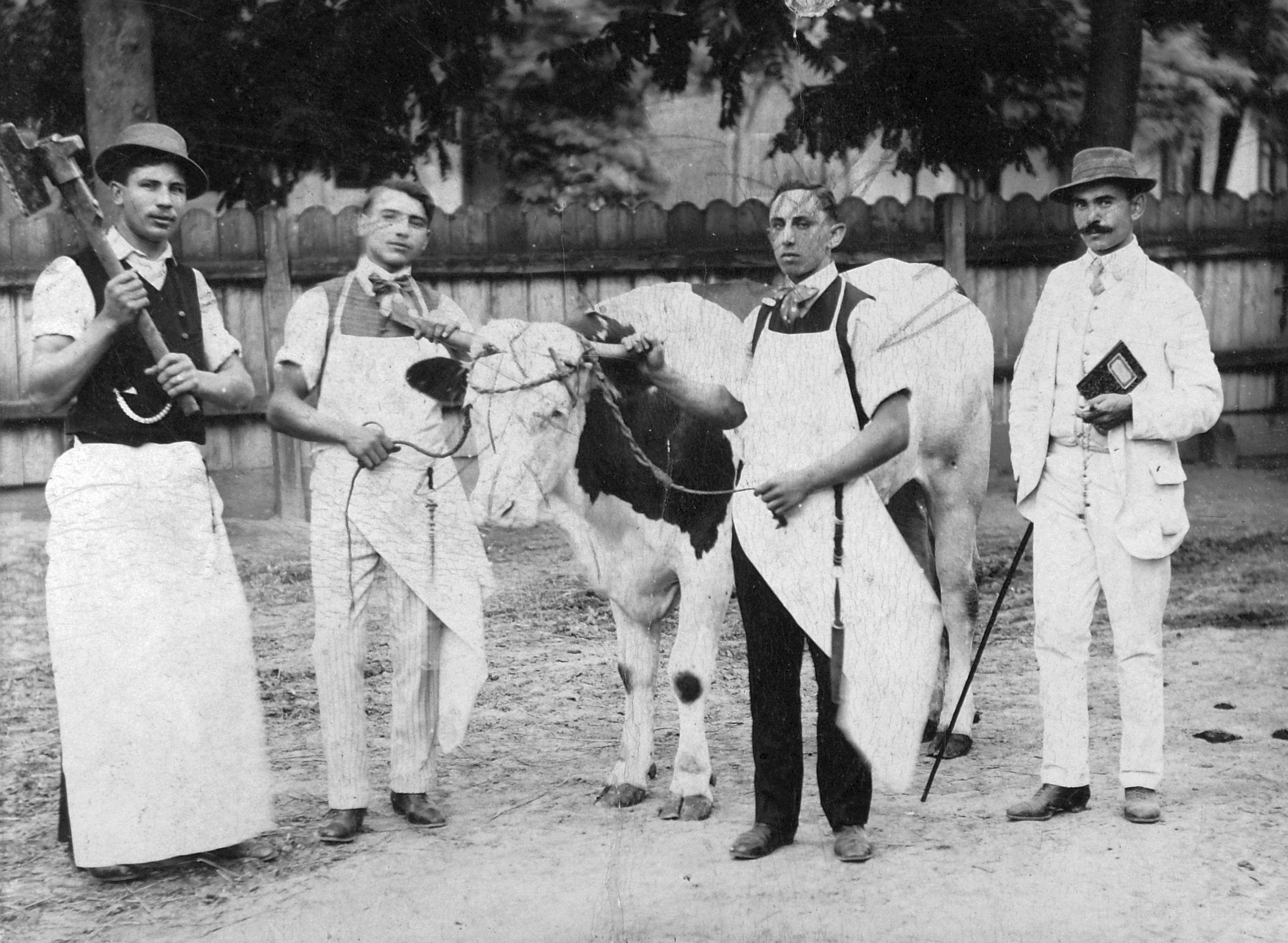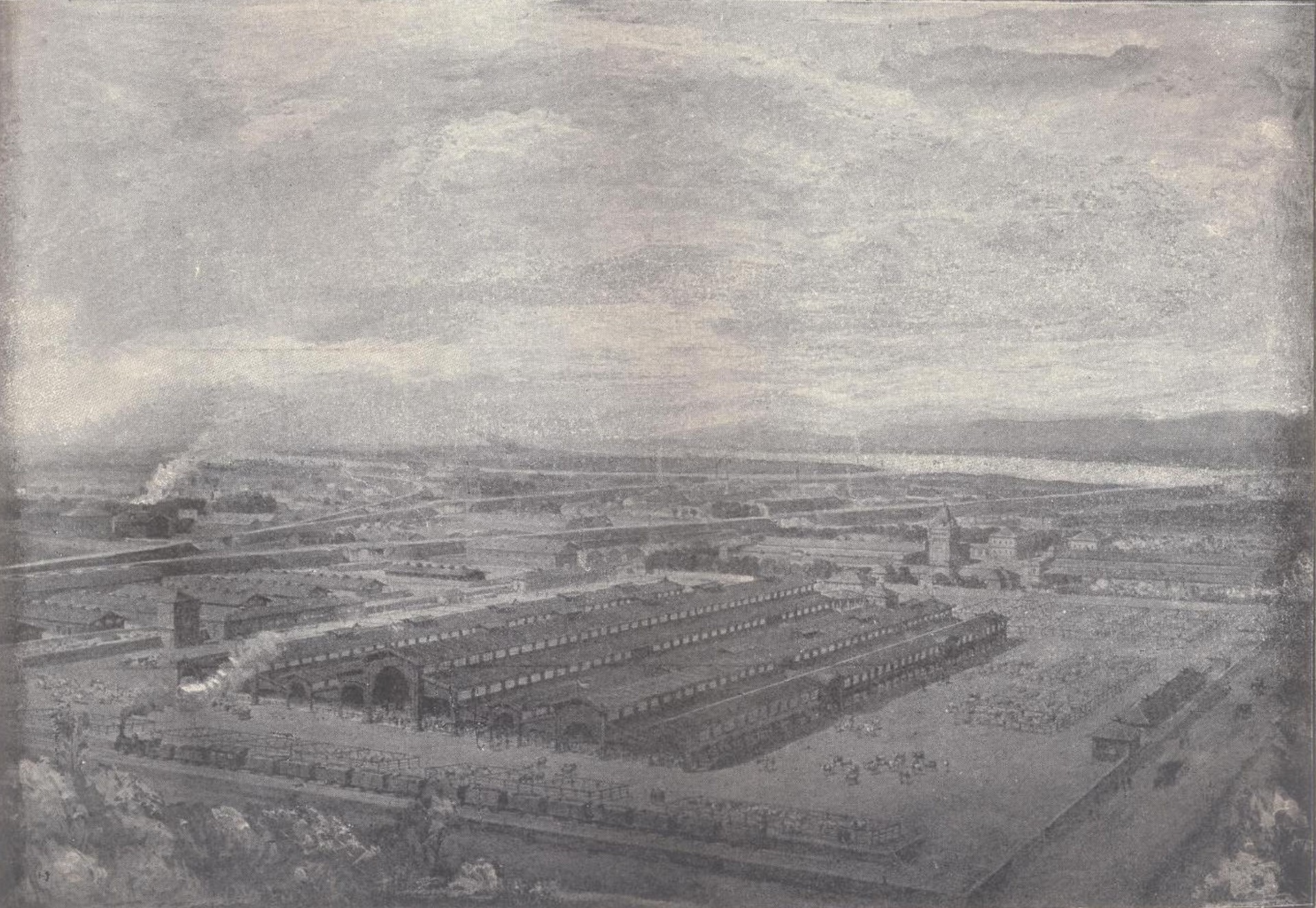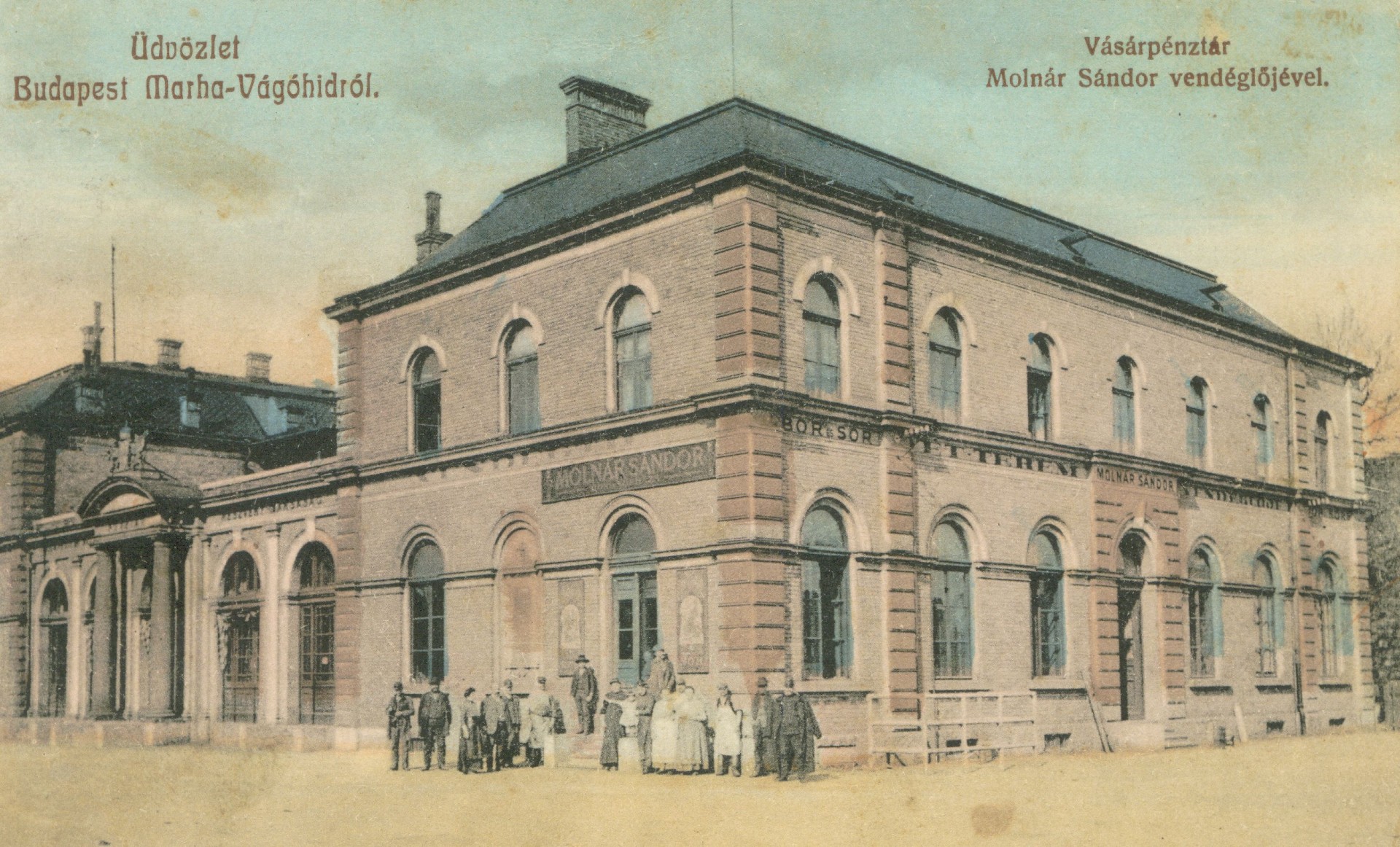At the time of the 1857 census, 131,000 people lived in Pest. This population had to be supplied with an adequate amount of meat, which was not an easy task. According to a report made in 1860, about nine thousand pigs and 40 thousand oxen were consumed in the capital in one year. At this time, cattle fairs were held in two places in Józsefváros, and pig fairs were held in Kőbánya. Incidentally, in the latter part of town, in the area close to Üllői Road, about 75,000 pigs were fattened.
The number of the population multiplied in the following decades, the demand for meat also grew, and the city management soon realized that if it wanted to solve public health aspects and the control of meat dealers and butchers at the same time, it had to act urgently. In Pest in 1861, 113 "mészáros-" and 112 "hentesmester" [both means master butcher in Hungarian] had operating licenses, all of them carried out their work within the framework of the old guilds (the "mészáros" primarily dealt with slaughtering cattle, horses, and less often sheep, the "hentes" worked with smaller animals: pigs and poultry). Most of them did their work near the Danube, in four places designated for this purpose, but these slaughterhouses had a very small floor area and could not really satisfy the constantly growing demand for meat.

Butchers around 1890 (Photo: Fortepan/Image number: 19895)
Apart from the butchers, many people slaughtered animals secretly in the yard of their houses, and the city authorities had difficulty controlling the densely built-up parts of the suburbs (such as Ferencváros or Józsefváros) with village-like houses. In 1861, the city council decided to solve the wide-ranging problems related to price regulation, hygiene, and slaughter without a permit by establishing a central slaughterhouse maintained by Pest. A special committee was also formed to oversee the preparations. Already in 1866, the committee, supplemented by architects, got to know the slaughterhouses operating in German and French territories on a study trip abroad. Two years later, an international design competition was announced.

The Közvágóhíd [Public Slaughterhouse] on a map published in 1903 (Source: Ferencvárosi Helytörténeti Gyűjtemény)
The first prize of 1,200 HUF was won by the Prussian architect Julius Hennicke, the second place went to Mór Hunträger from Vienna, and the third to the Prussian designer Samuel Pelka. The only Hungarian competitor, Károly Benko, was awarded a 400 HUF special prize by the jury. The works began in 1870, based on Hennicke's plan, at today's 58 Soroksári Road.
First, earthworks were carried out, and in some places the ground level had to be raised by 5 meters in order to compensate for the level difference of the steeply sloping area south of the city centre and the Danube bank. Ottó Rathey managed the large-scale construction, József Diescher carried out the masonry and stone carving work, the Neuschloss company was entrusted with the carpentry work, and Antal Oetl won the iron works. The area to be built on was approximately 138,000 square meters.

Perspective view from the 18 August 1872 issue of Vasárnapi Ujság
This huge complex of buildings, which was surrounded by a wall more than two meters high, was completed in two years. The so-called management buildings rose to the right and left of the main entrance, supplemented by stables and sheds. In the four corner buildings, a syringe warehouse, a workshop, and a space suitable for caring for sick animals were created. At the base of the walls along today's Vágóhíd Street and Máriássy Street, manure pits, as well as places for washing tripe and intestines, were established. In the middle of the slaughterhouse, a building was erected for the board of directors and the stock exchange, and behind them, on the part facing Soroksári Road, the tallest and perhaps the most beautiful building, the water tower, was located, the tank in the upper part of which was capable of storing 185 cubic meters of water.

The main entrance on a postcard from around 1890 (Source: Ferencvárosi Helytörténeti Gyűjtemény)

The water tower, the oxen waiting to be slaughtered in front of it (Source: Ferencvárosi Helytörténeti Gyűjtemény)
The settlement was officially opened on 23 July 1872. In the presence of about 300 invited guests, deputy mayor Károly Kamermayer inaugurated the institution, then architect Hennicke gave a brief presentation of the slaughterhouse, and finally a 5 quintal bull was slaughtered, and then, as it was written in the 26 July issue of Budapesti Közlöny: "the ceremony followed by a friendly brunch ended at 12:00".

The woodcut showing ceremonial slaughter from the 11 August 1872 issue of Magyarország és a Nagyvilág

In 1874, the Leipzig Illustrierte Zeitung also published a picture of the Közvágóhíd (Source: Ferencvárosi Local Helytörténeti Gyűjtemény)
Behind the Közvágóhíd, a cattle market was established, which was bordered by today's Mester Street, Máriássy Street and Vágóhíd Street. The fences of this area and the covered corrals with a large capacity were made by the Norwegian-born builder Gregersen Gudbrand and Endre Thék, who was a young novice at the time. The total cost of the slaughterhouse was 1,300,000 forints, and the equipment of the beef market was roughly 350,000 forints.

Behind Marhavásártér, on the line of today's Mester Street, a steam railway transported the processed goods (drawing from the book Budapesti közvágóhidak és állatvásárok [Public Slaughterhouses and Animal Markets in Budapest])
The huge investment turned out to be successful and for decades it solved the task of live animal trading and the previous problems related to animal slaughter, meat processing and further transport. In the first decades, the stables of the Közvágóhíd housed approximately 600 cattle, and in the 30 slaughterhouses, approximately 180 oxen could be slaughtered and processed daily. By the beginning of the 1900s (due to the further increase in the number of city dwellers and the increasing demand for exports), new slaughterhouses managed by the capital were needed.

Marhavásártér around 1900 (photo from the book Budapesti közvágóhidak és állatvásárok)
The Sertésvágóhíd [Pig Slaughterhouse] was completed on Gubacsi Road in 1902, and the Lóvágóhíd [Horse Slaughterhouse] opened next to it three years later. Close to the old Közvágóhíd, on the other side of Máriássy Street, the Borjúvásárcsarnok [Veal Market Hall] was also built in 1927, and this huge meat industry centre operated for many decades, sometimes as a state-owned and sometimes as a capital-owned company.
%4006-06-15.jpg)
The building of Borjúvásárcsarnok, which was transformed into an office building and thus remained in 2004 (Source: Ferencvárosi Helytörténeti Gyűjtemény)

According to the postcard published around 1890, there was also a restaurant at the slaughterhouse (Source: Ferencvárosi Helytörténeti Gyűjtemény)
Cattle were slaughtered at 58 Soroksári Road for the last time in the early 1980s, after which the Közvágóhíd area was known more as a meat wholesale centre. After the regime change, several smaller companies continued trading, the slaughter rooms were used as warehouses, but in the early 2000s, bands could also rent one of these rooms as rehearsal rooms. There was also a gambling business here, but there was also an idea that would have brought a red-light district to the area of the slaughterhouse.
In the end, not much of the various plans came to fruition. Anyone who travels there by car, tram or on foot these days can see that residential parks almost as high as the clouds are lined up side by side and behind each other, and the construction has by no means stopped. From the slaughterhouse handed over 150 years ago, the water tower, the boardroom and the stock exchange building, as well as the two beautiful statues decorating the main entrance, a bull, a buffalo and the figures of the boys who tamed them, remain today. Let's be happy that the memory of the former industrial complex is preserved as a visible memento.

Buffalo and boy (work of the German sculptor Reinhold Begas)
.jpg)
Bull and butcher's lad (work of the German sculptor Reinhold Begas)

The slaughterhouses photographed from under a connecting corridor in 2018 (Photo: László Lugosi / Ferencvárosi Helytörténeti Gyűjtemény)

View from the roof of one of the warehouse buildings in 2018 (Photo: László Lugosi / Ferencvárosi Helytörténeti Gyűjtemény)

Construction in the area of the former Közvágóhíd in 2019 (Photo: László Lugosi Lugo / Ferencvárosi Helytörténeti Gyűjtemény)
Cover photo: The main entrance of the Közvágóhíd on a postcard from around 1890 (Source: Ferencvárosi Helytörténeti Gyűjtemény)




































Hozzászólások
Log in or register to comment!
Login Registration